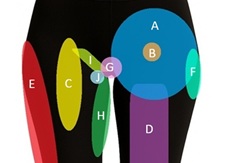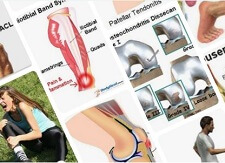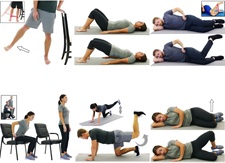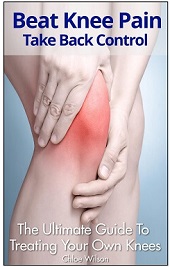- Home
- Hip Pain Diagnosis
- Inner Hip Pain
Inner Thigh Pain
Written By: Chloe Wilson, BSc(Hons) Physiotherapy
Reviewed by: KPE Medical Review Board
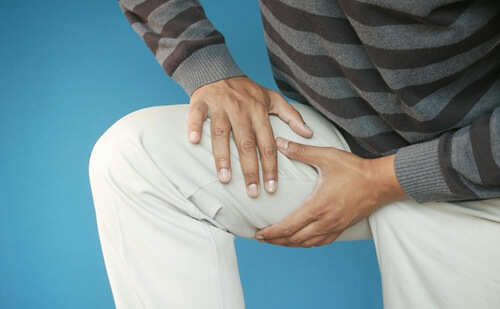
Inner thigh pain, often referred to as inner hip pain or groin pain, is a common issue that can affect people of all ages.
Whether it creeps in slowly with daily activity or strikes suddenly after an injury, inner thigh hip pain can really interfere with your movement and quality of life.
It may be a simple issue like a pulled hip muscle or a sign of something more serious like an infection.
In this guide, we’ll look at the most common causes of inner thigh pain, what symptoms to look out for, how it’s diagnosed, when to see a doctor, and the most effective treatment options.
If your pain is in a different part of the hip or thigh check out the following articles: front hip pain, outer hip pain and upper thigh pain or have a look at our hip pain diagnosis charts.
Causes of Inner Thigh Pain
There are a number of possible causes of pain in the inner thigh that all present slightly differently:
1. Adductor/Groin Strain
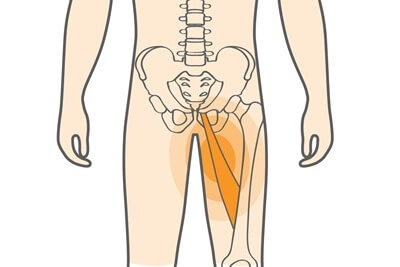
A groin strain is one of the most frequent causes of inner hip and groin pain, especially in athletes.
It happens when the adductor muscles (the muscles which bring your legs together) are overstretched or torn. This can happen suddenly during quick movements or gradually from overuse, particularly if you don’t warm up properly or stretch.
Common symptoms of an adductor strain include sharp pain in the inner thigh, especially during side-to-side movement, swelling, bruising and reduced strength in the leg. You may also notice a popping sound at the time of injury.
Find Out More: Groin Strain
2. Hip Impingement Syndrome
Femoroacetabular impingement (FAI), aka hip impingement syndrome, is another common cause of inner hip and thigh pain. It occurs when the bones of the hip joint are abnormally shaped with extra bone growth. This causes abnormal contact between the ball and socket of the hip joint resulting in friction and irritation. This can lead to cartilage damage and cause inner hip pain.
There are three types of impingement, Cam, Pincer and Mixed depending on where the bone growth is.
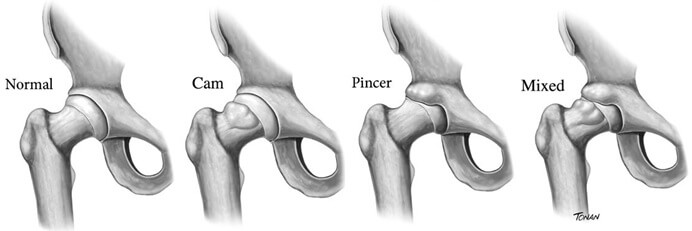
Common symptoms of hip impingement syndrome include a deep aching hip and groin pain, sharp inner hip thigh with leg movements, reduced range of motion and occasional clicking or locking. Symptoms often worsen with activities that involve hip rotation or flexion.
Find Out More: Femoroacetabular Impingement
3. Hip Arthritis
Osteoarthritis or inflammatory arthritis in the hip is a common cause of hip and inner thigh pain in older adults. As the cartilage wears down or inflammation builds up, the joint becomes stiff, swollen, and painful.
Common symptoms of hip arthritis include a dull ache in the groin or thigh, stiffness in the morning or after rest, pain that worsens with activity, grinding or creaking sounds with movement and weakness in the leg.
Hip osteoarthritis is most common in people over the age of 60, or those with a history of joint overuse or previous hip injuries.
4. Hip Labral Tear
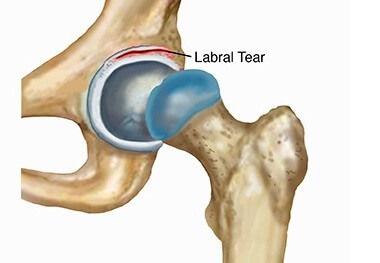
Another possible cause of inner hip and thigh pain is a hip labral tear.
The labrum is a ring of cartilage that surrounds the hip socket, to improve its stability and provide cushioning. Tears in the labrum can lead to instability and pain in the inner thigh.
Hip labral tears are usually caused by sudden impact e.g. a fall, repetitive overuse e.g. pivoting movements in sport, hip impingement or gradual degeneration.
Common symptoms of hip labral tears include clicking, catching or locking of the hip, pain with rotation or twisting, inner thigh or groin discomfort and reduced hip mobility. Pain can be sharp or deep or persistent.
Find Out More: Hip Labral Tears
5. Hernia
Inner thigh pain that is accompanied by a lump in or around the groin often indicates a hernia. Hernias occur when internal tissue pushes through a weak spot in the abdominal wall.
The most common type that causes inner hip and thigh pain is an Inguinal Hernia, where part of the intestine or fatty tissue protrudes through the inguinal canal in the groin. It often presents as a bulge that increases in size when straining or coughing and may cause a burning or aching sensation in the groin area.
6. Nerve Pain
Nerve compression either in the lower back or front of the pelvis can cause referred pain into the inner thigh. Common culprits include lumbar disc herniation, spinal stenosis, or entrapment of the obturator or femoral nerve.
Common symptoms of inner thigh pain from nerve issues are burning, tingling, or shooting pain in the inner hip and thigh, numbness, pins and needles, and sometimes weakness. Symptoms often worsen with standing or walking.
Another possible nerve problem is Meralgia Paresthetica, which usually causes outer thigh symptoms, but in rare cases can affect the inner thigh due to nerve variation.
7. Oseitis Pubis
Osteitis Pubis is an inflammatory condition affecting the pubic symphysis, the joint at the front of the pelvis, and nearby muscles and joints.
It is common in athletes and pregnant women due to repetitive stress or biomechanical changes in the pelvis.
Typical symptoms include an aching hip and groin pain, stiffness, pain that worsens with running, kicking, sit-ups, or rising from a seated position. It can cause difficulty with single-leg activities.
Find Out More: Osteitis Pubis
8. Symphysis Pubis Dysfunction

Common during pregnancy, symphysis pubis dysfunction (SPD) happens when the ligaments of the pelvic joint become too relaxed allowing the pelvis to move unevenly.
Typical symptoms of symphysis pubis dysfunction include burning or shooting pain in the inner thigh, groin, and pelvis, especially when walking, getting in/out of a car, or rolling over in bed. A clicking or grinding feeling in the pelvic region is also common.
SPD is usually associated with hormonal changes, increased joint laxity, and postural alterations during pregnancy, and typically starts during the second trimester. Wearing a pelvic support belt can really help reduce hip and inner thigh pain and instability from SPD.
Find Out More: Symphysis Pubis Dysfunction
Other Causes of Inner Hip Pain
There are some other less common causes of pain in the inner hip and thigh:
- Kidney Stones: Pain from kidney stones can radiate down to the inner thigh, especially if the stone is moving through the ureter. Typical symptoms include pain when urinating, increased frequency and urgency to urinate and urine that is cloudy or smells different to normal
- Fractures: Stress fractures of the pelvis or femur can cause a gradual onset of localized hip and inner thigh pain, especially with weight-bearing. They are usually caused by sudden increases in physical activity. More serious pelvic and hip fractures are caused by sudden major injuries such as a fall or road traffic accident
- Enlarged Lymph Nodes: Infections or other conditions can lead to swollen lymph nodes in the groin, which can feel tender and painful
- Deep Vein Thrombosis: while DVT’s (a serious type of blood clot) usually occur in the calf region, they can also form in thigh and can be life-threatening if they break off and travel to the lungs, heart or brain. Symptoms of a DVT may include swelling, warmth, tenderness and inner thigh pain. If you experience any of the following, seek urgent medical attention - sudden shortness of breath, chest pain, rapid pulse, coughing up blood, slurred speech, one-sided weakness and/or numbness, loss of consciousness
Symptoms of Hip & Inner Thigh Pain
The type and severity of symptoms associated with inner hip and thigh pain vary depending on the underlying cause, but often include:
- Sharp Pain: or dull ache in the hip, groin or inner thigh which may radiate down to the knee
- Muscle Tightness: or stiffness in the inner thigh with reduced hip range of motion
- Difficulty Walking: with hip and inner thigh pain and weakness when bearing weight
- Difficulty Moving Your Leg: you may have difficulty lifting and holding your leg up, crossing your legs, moving the leg side to side and getting in and out of bed
- Swelling: bruising or a palpable lump
- Clicking or Popping Sensations: in the hip when moving the leg or walking
- Burning or Tingling: or pins and needles and numbness which indicate nerve involvement
Diagnosing Inner Hip And Groin Pain
Diagnosing the cause of pain in the inner thigh, hip or groin usually involves a detailed physical exam and medical history. Depending on your symptoms, your doctor may order:
- X-rays or MRI scans
- Ultrasound to check for soft tissue injuries
- Nerve conduction tests
- Urine or blood tests (if infection is suspected)
When to See a Doctor
See your regular doctor if you have:
- Persistent or worsening hip and inner thigh pain
- Pain interfering with daily activities
- Swelling or weakness in the thigh
- Clicking or catching sensations in the hip
Seek urgent medical attention if you have:
- Sudden, severe inner thigh hip pain after a fall or injury
- Inability to move or bear weight
- Signs of infection - fever, redness, warmth
- Sudden numbness or loss of sensation
#CommissionsEarned from Amazon on qualifying purchases
Treatment for Inner Thigh Pain
Inner hip pain treatment depends on the root cause, but common options include:
- Rest & Activity Modification: Limiting activities that exacerbate pain is crucial to allow the affected tissues to heal. Gradually reintroduce activities ensuring they don’t provoke discomfort
- Cold & Heath Therapy: Applying ice packs to the inner thigh for 15-20 minutes several times a day during the initial 48-72 hours can reduce inflammation and numb the area, providing pain relief. After a few days, using warm compresses can relax tight muscles and improve blood flow, aiding in the healing process
- Anti-Inflammatory Medications: Non-steroidal anti-inflammatory drugs (NSAIDs) like ibuprofen or naproxen can help manage hip and inner thigh pain and inflammation
- Physical Therapy: A tailored rehab program can restore mobility, improve strength, and correct underlying movement patterns that may be contributing to the problem
- Stretching and Strengthening Exercises: Targeted hip strengthening exercises and stretches for the adductors, hip flexors, glutes, and core can prevent recurrence and improve stability
- Manual Therapy: Techniques like massage, joint mobilizations, or myofascial release can help relieve hip and inner thigh pain and restore mobility and hip range of motion
- Supportive Devices: Compression shorts, hip braces, or orthotics can help reduce strain and improve biomechanics
- Injections: Cortisone injections may be used to reduce inflammation in joints, while nerve blocks can help with neuropathic pain
- Lifestyle Modifications: Losing excess weight, avoiding aggravating activities, or improving posture and gait mechanics may also play a key role
- Surgery: In severe or unresponsive cases, surgery may be necessary e.g. with labral tears, hip impingement or hip fractures.
You can find out more about specific treatment for the different causes of inner thigh pain in the following articles:
- Groin Strain Treatment
- Hip Impingement Treatment
- Hip Labral Tear Treatment
- Meralgia Paresthetica Treatment
- Osteitis Pubis Treatment
- Symphysis Pubis Dysfunction Treatment
Inner Thigh Pain Summary
Inner thigh pain can come from many different sources, ranging from strained hip muscles and irritated joints to deeper issues like nerve compression or pelvic dysfunction. It is important to identify the underlying cause to get the right treatment.
If you're dealing with inner thigh pain, inner hip pain, or general hip and groin pain, don’t ignore it. The sooner you get to the root of the problem, the faster you can get back to moving comfortably again.
You may also be interesting in the following articles:
- Front Hip Pain
- Inner Knee Pain
- Hip Range Of Motion
- Femoroacetabular Impingement Hip
- Pain In Top Of Thigh
- Hip Labral Tear
Related Articles
Hip Pain Diagnosis
September 16, 2025
Knee Pain Diagnosis
March 27, 2025
Hip Strengthening
September 24, 2025
Last Updated: September 14th, 2025
Next Review Due: September 14th, 2027
